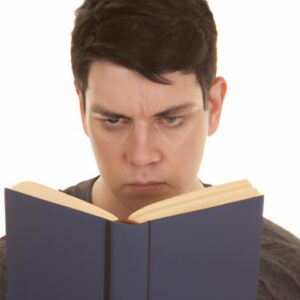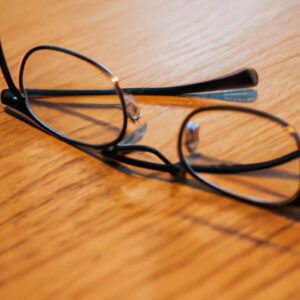Introduction
When it comes to reading glasses, finding the right pair can make all the difference in the world. Imagine the frustration of straining your eyes or experiencing headaches while trying to enjoy your favorite book or browse through a magazine. The truth is, choosing the right reading glasses is essential for a comfortable and enjoyable reading experience.
But let’s debunk a common misconception first. Reading glasses are not a sign of aging or weakness. They are a tool designed to assist individuals with presbyopia, a natural condition that affects most people as they age. So, whether you’re in your 40s, 50s, or beyond, finding the perfect reading glasses is crucial for maintaining optimal eye health and enhancing your reading pleasure.
The purpose of this article is to guide you through the process of selecting the right reading glasses. We’ll address common misconceptions, discuss the importance of choosing the correct strength, and provide valuable tips to ensure you find the perfect pair for your needs. So, let’s dive in and discover which reading glasses you truly need!
Stay tuned for the next section, where we’ll explore the symptoms and causes of presbyopia, the condition that necessitates the use of reading glasses.
Understanding Presbyopia and its Symptoms
Definition and Causes of Presbyopia
Presbyopia is a common age-related eye condition that affects the ability to focus on close objects. It occurs when the lens of the eye loses its flexibility, making it challenging to see nearby objects clearly. Unlike other refractive errors like nearsightedness or farsightedness, presbyopia is not caused by the shape of the eye but rather by the natural aging process.
As we age, the lens becomes less elastic, making it difficult for the eye muscles to adjust and focus on objects up close. This condition typically becomes noticeable around the age of 40 and progressively worsens over time. While presbyopia is a natural part of aging, it doesn’t mean you have to sacrifice your reading comfort. That’s where reading glasses come into play.
Symptoms and Signs of Presbyopia
Wondering if presbyopia might be the culprit behind your blurry vision? Look out for these common symptoms:
- Difficulty reading small print: Do you find yourself holding your book or phone at arm’s length to see clearly?
- Eye strain and fatigue: Do your eyes feel tired or strained after extended periods of reading or focusing on nearby objects?
- Headaches: Do you experience headaches, especially when engaging in close-up tasks?
If you’re nodding along, chances are you’re experiencing presbyopia. It’s essential to recognize these signs and address them promptly to avoid discomfort and further eye strain.
Importance of Addressing Presbyopia with Reading Glasses
Presbyopia may be an inevitable part of aging, but it doesn’t mean you have to compromise on your reading pleasure. Reading glasses are specifically designed to compensate for the loss of focusing ability caused by presbyopia. By providing the necessary magnification, reading glasses allow your eyes to relax and focus effortlessly on close-up objects.
Ignoring presbyopia can lead to eye strain, headaches, and reduced productivity. By addressing presbyopia with the right reading glasses, you can maintain clear vision, prevent unnecessary discomfort, and continue enjoying your favorite books, magazines, and digital screens.
In the next section, we’ll delve into the factors you should consider when choosing the perfect reading glasses. Stay tuned to find out how to determine the strength you need and explore the different types and styles available.
Factors to Consider When Choosing Reading Glasses
When it comes to selecting the perfect reading glasses, there are several key factors to take into consideration. Let’s explore each of these factors to ensure you make an informed decision:
A. Importance of an Eye Examination
Before purchasing reading glasses, it’s essential to undergo an eye examination. This examination will determine the exact strength of reading glasses you require. It’s crucial to note that reading glasses are not one-size-fits-all, as everyone’s eyesight is unique. An optometrist will conduct a thorough assessment to determine your specific needs, ensuring optimal vision correction and comfort.
B. Understanding the Diopter Measurement
The diopter measurement is a crucial aspect to consider when choosing reading glasses. It represents the lens power required to correct your vision. The higher the diopter number, the stronger the lens. Understanding this measurement will assist you in selecting the appropriate strength for your reading glasses, preventing eye strain and discomfort during extended reading sessions.
C. Different Types of Reading Glasses Available
Reading glasses come in various forms, each catering to different needs and preferences. Some common types include full-frame, half-frame, and folding reading glasses. Full-frame glasses provide the same lens strength throughout, while half-frame glasses allow you to peer over the frames when focusing on distant objects. Folding reading glasses offer convenience and portability. Consider your lifestyle and vision requirements to determine which type suits you best.
D. Frame Styles and Materials
When choosing reading glasses, don’t forget to consider the frame styles and materials. Frames come in a multitude of designs, ranging from classic to trendy, ensuring you find a pair that matches your personal style. Additionally, frame materials such as metal, plastic, or a combination of both offer different levels of durability and comfort. Select frames that not only complement your face shape but also provide a comfortable fit for extended wear.
Now that we’ve discussed the essential factors to consider, in the next section, we’ll delve into determining the strength of reading glasses you need. Stay tuned to find out how to select the perfect strength for your reading pleasure.
How to Determine the Strength of Reading Glasses You Need
Finding the right strength of reading glasses is crucial to ensure clear vision and avoid unnecessary strain on your eyes. Luckily, there are a few ways to determine the strength that suits you best. Let’s explore these methods:
A. DIY tests to estimate your reading glasses strength
If you’re curious about your reading glasses strength, you can try a simple DIY test. Start by grabbing a magazine or a book with small text and find a well-lit area. Hold the reading material at a comfortable distance and try out different pairs of reading glasses with varying strengths. Pay attention to the clarity and sharpness of the text.
Ask yourself: “Can I read the text easily without squinting or straining my eyes?” If the answer is yes, you may have found the right strength. However, keep in mind that this method provides only a rough estimate and doesn’t substitute for a professional prescription.
B. Visiting an optometrist for a professional prescription
For a more accurate reading glasses strength assessment, it’s recommended to consult an optometrist. Optometrists have the expertise and tools to measure your vision and prescribe the appropriate reading glasses strength. They will conduct a comprehensive eye examination, including tests to assess your near and distance vision.
By visiting an optometrist, you can ensure that your reading glasses are tailored specifically to your eyes and visual needs. This professional approach will provide you with the most accurate prescription, allowing you to enjoy optimal vision while reading.
C. Understanding the numbers on your reading glasses
Once you have your reading glasses prescription, it’s important to understand the numbers on your glasses. The strength of reading glasses is typically represented by the term “diopters” (D). Positive numbers indicate magnifying lenses for farsightedness, while negative numbers indicate magnification for nearsightedness.
For example, if your prescription shows +2.00D, it means you need a +2.00 strength for clear and comfortable near vision. Understanding these numbers will help you choose the right reading glasses when shopping or ordering online.
In the next section, we’ll provide valuable tips for finding the perfect reading glasses, taking into account your lifestyle and reading habits. Stay tuned!





